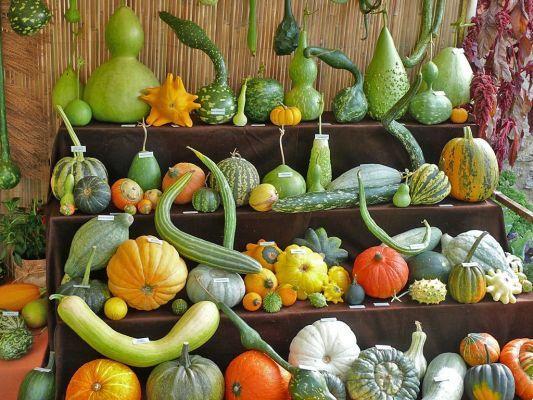
Let's start by making a minimum of clarity: the vulgar name pumpkin, also accepted commercially, it refers to the fruits of various species of the genus Cucurbita, plus some fruits of the genera Lagenaria, Benincasa, Trichosanthes and Momordica, always of the Cucurbitaceae family.
Both the term pumpkin and the name of the genus, Cucurbita, have an ancient etymology that refers to the head (cucuzza and zucchetto), as the pumpkin can resemble a human head in shape and size and in certain ancestral rites it can replace it, as in the case of the sinister Jack-o'-lantern.
Read also Recipes with pumpkin for Halloween >>
The origins of the pumpkin
The pumpkin of the genus Cucurbita is native to North America and for centuries it has been one of the main foods of the natives, one of the famous “Three sisters”: corn, beans and pumpkin.
The corn served as a support for the beans, which in turn fixed nitrogen for the pumpkins, and the pumpkins, creating a low layer that covered the soil from direct light, prevented weeds from growing and competing with corn. However, with the exception of Antarctica, pumpkin is nowadays a universal food, easy to grow, convenient to carry and store, great to eat.
Archaeological studies show that at the beginning the pumpkin was eaten exclusively roasted, and that the skins were dried to obtain containers and bowls, as is still the case today. Today there are countless ways to prepare pumpkin: steamed, boiled, fried, fermented, baked, raw, salted, pickled, etc.
The various types of pumpkin
We now come to a short list of all the fruits that we commonly call pumpkin.
1. The sweet pumpkin
Cucurbita maxima, e ' the classic yellow or orange pumpkin, rich in beta-carotene, which we find around in the markets in different varieties. Generally round and large, it has vertical grooves that distinguish it.
2. The courgette
It is the immature and sweet fruit of Cucurbita pepo, it can be found on the market in different varieties: yellow, light green, dark green, more or less long, round or patisson, or discoid.
3. The trumpet pumpkin
It responds to the scientific name of Cucurbita moschata and it is oblong, rich in orange pulp and has a fine and smooth skin.
4. The pumpkin in flask
Made up more or less of two globes and green in color, Lagenaria siceraria is instead originally from Europe and it has been used in soups and soups since ancient times, as well as to make musical instruments.
5. Benincasa hispida, winter squash: the only member of the genus Benincasa
It is generally eaten cooked before it reaches full maturity, as the plpa is sweet and not sticky. It is a Cucurbitaceao native to India.
6. The Trichosanthes cucumerina or snake gourd
It is a climbing cucurbit native to Asia that has long and curved fruits with a thin skin and spongy pulp, excellent when cooked together with other vegetables.
7. The Momordica Genus in the Cucurbitaceae Family
Here we find various species such as the thorny gourd, gac and bitter melon which are often considered gourds.
The flavor of these fruits varies from very bitter to neutral sweet. Originally from Southeast Asia and much loved in China, they are becoming increasingly popular with us too, especially for their excellent nutritional qualities.
Read also Pumpkin bread: the recipe, properties and nutritional values >>


























